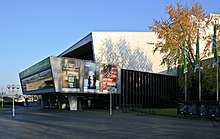Bonn Opera
The Bonn Opera is the municipal opera house of the federal city of Bonn . It forms one of the three properties Theater Bonn , an establishment similar to that of the Federal City of Bonn, and is also operated by this.
Opera house
The opera house is centrally located on the banks of the Rhine in Bonn , directly on the Kennedy Bridge in the area of the former Rheinviertel . The new building was built from 1962 to 1965 on the former site of the Boeselager Hof, which was destroyed in the war, as a city theater based on plans by the Stuttgart architects Klaus Gessler and Wilfried Beck-Erlang . The building was financially supported by the federal government to promote the cultural offerings at the then parliament and government seat in Bonn. Originally designed for 900 seats in the main room and 180 seats in the “workshop”, since the expansion of its auditorium in the 1992/93 season, it has accommodated 1,037 visitors and is now used exclusively by the opera. One of the artistic features of the building is the lighting of the auditorium in the form of a lowerable Milky Way , which, like the imaginative chandeliers in the parquet foyer, was designed by the ZERO artist Otto Piene . The parts of the building are made of reinforced concrete and aligned along the Rhine. The metal plates on the outer walls are arranged like fish scales.
The opera house is used for operas, musicals, international dance guest performances, concerts and theater festivals. Comedy, cabaret and cabaret are also part of the QUATSCH KEINE OPER! for the performance. In the music theater, the offer ranges from works of the 20th century to Italian operas and family performances. The Bonn Opera has a permanent opera ensemble, which is expanded to include guests in individual cases.
Trivia
- The architecture critic Ingeborg Flagge rated the building in 1984 as follows: "In terms of the conception of presenting the theater as a dynamic, free structural form, this building means turning away from cubic theater architecture."
- In the opera house there are guided tours "behind the scenes", in which, among other things, the workshops and the stage technology are shown.
literature
- Ursel and Jürgen Zänker: Building in Bonn room 49–69. Attempt to take stock . In: Landschaftsverband Rheinland (Hrsg.): Art and antiquity on the Rhine . Guide to the Rheinisches Landesmuseum Bonn . No. 21 . Rheinland-Verlag, Düsseldorf 1969, p. 169-171 .
- Ingeborg flag : Architecture in Bonn after 1945: Buildings in the federal capital and its surroundings . Verlag Ludwig Röhrscheid, Bonn 1984, ISBN 3-7928-0479-4 , p. 66.
- Andreas Denk , Ingeborg flag: Architectural guide Bonn . Dietrich Reimer Verlag, Berlin 1997, ISBN 3-496-01150-5 , p. 18.
- Workshop Baukultur Bonn (Ed.): City Theater (= architecture guide of the workshop Baukultur Bonn , ISSN 2196-5757 , Volume 3). Edition Critical Edition, Bonn 2015.
Individual evidence
- ↑ Ice cubes in tinfoil . In: Der Spiegel . No. 20/1965, pp. 118–120 ( available online (PDF; 355 kB)). Retrieved November 13, 2016.
- ^ Hermann Josef Roth : DuMont art travel guide Bonn: from the Roman garrison to the federal capital - art and nature between the Voreifel and the Siebengebirge . DuMont, Cologne 1988, ISBN 978-3-7701-1970-7 , pp. 85/86.
- ^ Bonn - Pictures from the capital. With texts by Ernst Ney , Verlag B. Nolden, Bonn 1978. (with translations into English by Christiane Koch and into French by Jean-Paul Wayenborgh)
- ↑ theater . Information on the website of the city of Bonn. Retrieved November 25, 2012.
Web links
- Bonn Opera (and theater)
- Bonn Opera on Baukunst-nrw
- "Timelessly beautiful" The Bonn Opera on general-anzeiger-bonn.de
Coordinates: 50 ° 44 ′ 12 ″ N , 7 ° 6 ′ 25 ″ E





